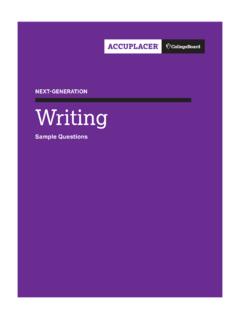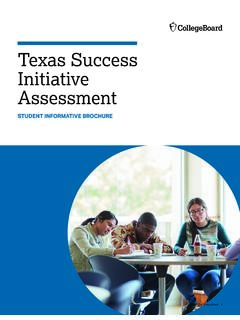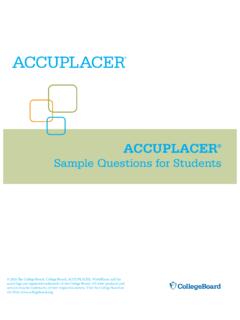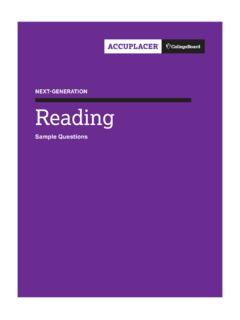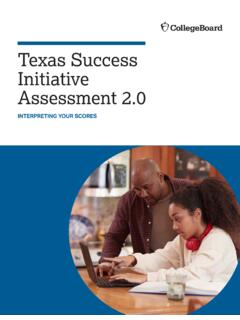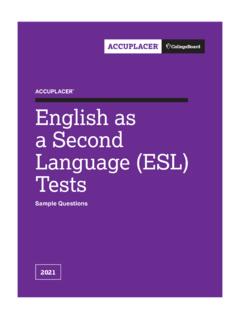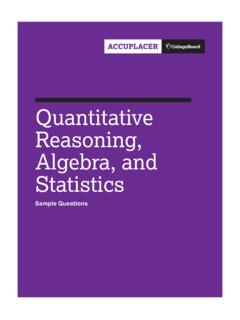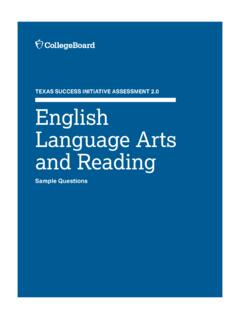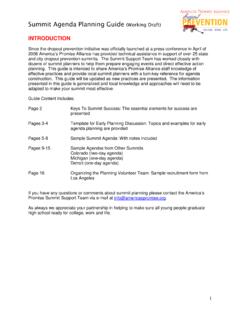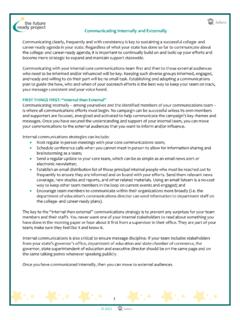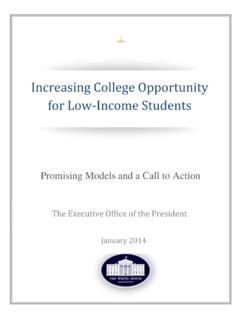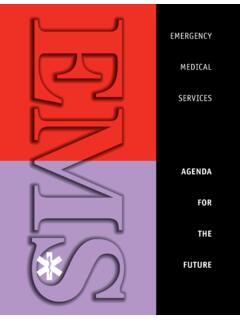Transcription of NEXT-GENERATION ACCUPLACER Test Specifications
1 Test Specifications Version NEXT-GENERATION ACCUPLACER NEXT-GENERATION ACCUPLACER Test Specifications The college Board The college Board is a mission-driven not-for-profit organization that connectsstudents to college success and opportunity. Founded in 1900, the CollegeBoard was created to expand access to higher education. Today, the membershipassociation is made up of over 6,000 of the world s leading education institutionsand is dedicated to promoting excellence and equity in education. Each year, theCollege Board helps more than seven million students prepare for a successfultransition to college through programs and services in college readiness andcollege success including the SAT and the Advanced Placement Program.
2 The organization also serves the education community through research andadvocacy on behalf of students, educators, and schools. For further information, visit This document describes the redesign of ACCUPLACER being undertaken by theCollege Board. This initial release provides an overview of the rationale behindthe redesign, its aims and nature, and information about key components of thenew, NEXT-GENERATION ACCUPLACER . Subsequent releases will provide additionalinformation for various audiences on specific topics related to the redesign. 2017 The college Board. college Board, ACCUPLACER , Advanced Placement Program, AP, SAT,WritePlacer, and the acorn logo are registered trademarks of the college Board.
3 COMPANION and PSATare trademarks owned by the college Board. PSAT/NMSQT is a registered trademark of the CollegeBoard and National Merit Scholarship Corporation. All other marks are the property of their respectiveowners. Visit the college Board on the web: 2 NEXT-GENERATION ACCUPLACER Test Specifications Contents 5 List of Tables 6 Executive Summary 7 SECTION I.
4 Behind the Redesign 7 Rationale for the Redesign 7 Alignment to the Redesigned SAT Suite of Assessments 10 SECTION II: Overview of NEXT-GENERATION ACCUPLACER 11 Computer-Adaptive Testing 12 SECTION III: Specifications of NEXT-GENERATION ACCUPLACER 12 Reading Placement Test 12 Test Description 12 Test Summary 13 Key Features 15 Writing Placement Test 15 Test Description 16 Test Summary 18 Key Features 20 Math: Arithmetic Placement Test 20 Test Description 21 Test Summary 21 Key Features 22 Math: Quantitative Reasoning, Algebra, and Statistics Placement Test 22 Test Description 23 Test Summary 24 Key Features 24 Math: Advanced Algebra and Functions Placement Test 24 Test Description 25 Test Summary 26 Key Features 27 SECTION IV.
5 Developing NEXT-GENERATION ACCUPLACER 27 Guiding Principles of the college Board s Test Development Process 27 The Test Development Process 28 Defining the Test Domains 28 Test and Question/Task Specifications 28 Stimuli and Question Development 29 Content and Fairness Reviews Prior to Pretesting 30 Pretesting 30 Postoperational Administration Statistical Review 3 NEXT-GENERATION ACCUPLACER Test Specifications 30 COMPANION Forms 30 COMPANION Form Content and Fairness Review 31 SECTION V: Conclusion 32 APPENDIX Text Complexity (Qualitative): Reading and Writing 4 NEXT-GENERATION ACCUPLACER Test Specifications List of Tables 10 Table 1: ACCUPLACER Suite (2016 Launch) 12 Table 2: Reading Placement Test Content Specifications 13 Table 3: Reading Placement Test Question Content 16 Table 4: Writing Placement Test Content Specifications 17 Table 5: Writing Placement Test Question Content 21 Table 6: Arithmetic Placement Test Content Specifications 21 Table 7: Arithmetic Placement Test Question Content 23 Table 8.
6 Quantitative Reasoning, Algebra, and Statistics Placement Test Content Specifications 23 Table 9: Quantitative Reasoning, Algebra, and Statistics Placement Test Question Content 25 Table 10: Advanced Algebra and Functions Placement Test Content Specifications 26 Table 11: Advanced Algebra and Functions Placement Test Question Content 5 NEXT-GENERATION ACCUPLACER Test Specifications Executive Summary For over 30 years, ACCUPLACER has been used successfully in combination withfactors such as high school GPA to assess student preparedness for postsecondaryeducation. Tests within the ACCUPLACER suite are delivered over the internet1 and are used extensively by high schools, community colleges, four-year colleges,and technical schools around the world.
7 ACCUPLACER test scores are used to inform college placement decisions and to identify where students are likely to bepositioned or likely to succeed within a postsecondary course framework. In 2016,11 million ACCUPLACER tests were administered. While research confirms that ACCUPLACER effectively identifies students strengths and weaknesses in core subjects reading, writing, and math research has emerged in recent years showing that: there has been an increase in the number of students enrolling in college remediation courses remedial course enrollment and/or completion may not propel students towardcollege completion . Recognizing the need for a comprehensive effort to help all students achieveboth college readiness and college success, the college Board has committedto an agenda that focuses on propelling students toward attainment of thesegoals.
8 A major component of this agenda is the redesign of ACCUPLACER , or thedevelopment of NEXT-GENERATION ACCUPLACER . This document describes the redesign of ACCUPLACER . Section I discussesthe rationale for the redesign and presents the alignment of the next-generationACCUPLACER tests to the redesigned SAT Suite of Assessments. Section II provides a summary of the features of the NEXT-GENERATION ACCUPLACER . Section IIIoffers detailed information about the individual components of the new IV discusses the exacting process of the redesign. 1. COMPANION forms are available for students who need special accommodations or when technologyis lacking for online testing.
9 These fixed-length linear tests are equivalent to the online, computer-adaptivetests (CAT) in Specifications . Test formats include braille, regular and large-print test booklets and answersheets, and audio CD. 6 NEXT-GENERATION ACCUPLACER Test Specifications SECTION I Behind the Redesign Rationale for the Redesign ACCUPLACER , an assessment for measuring student readiness for credit-bearingcollege courses, has been administered for over 30 years. During this time, theCollege Board has paid close attention to: evidence concerning essential prerequisites for college and career readinessand success changes in academic standards, curriculum, and instruction in the areas of reading, writing, and math feedback from ACCUPLACER users, including faculty, teachers, counselors,focus groups, advisory panels, and institutions feedback from high school and higher education stakeholders who use criteriaother than ACCUPLACER scores to make course placement decisions The NEXT-GENERATION ACCUPLACER tests, incorporating the above input andfeedback, aim to.
10 Clearly and transparently focus on knowledge, skills, and understandings thatresearch evidence shows are essential for college and career readiness andsuccess assist high school and higher education institutions in selecting andimplementing a course placement system that reduces, as much as possible,student testing time while increasing course placement accuracy and precision provide assessment scores that are used, along with information from othersources ( , high school transcripts, noncognitive data, degree programrequirements, SAT scores), by academic advisors to make course placementrecommendations direct test takers to specific, actionable, evidence-based interventions intendedto accelerate their progress toward college and career readiness and success Alignment to the Redesigned SAT Suite of Assessments NEXT-GENERATION ACCUPLACER is deeply informed by evidence attesting to theessential requirements for college and career readiness and success.
